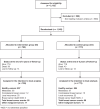The Effect of Diet on Breast Cancer Recurrence: The DIANA-5 Randomized Trial
- PMID: 37847493
- PMCID: PMC10905522
- DOI: 10.1158/1078-0432.CCR-23-1615
The Effect of Diet on Breast Cancer Recurrence: The DIANA-5 Randomized Trial
Abstract
Purpose: The DIANA-5 randomized controlled trial assessed the effectiveness of a diet based on Mediterranean and macrobiotic traditions (macro-Mediterranean diet) in reducing breast cancer recurrence.
Patients and methods: The DIANA-5 study involved 1,542 patients with breast cancer at high risk of recurrence because of estrogen receptor-negative cancer, or metabolic syndrome, or high plasma levels of insulin or testosterone. Women were randomly assigned to an active dietary intervention (IG) or a control group (CG). Both groups received the 2007 American Institute for Cancer Research/World Cancer Research Fund recommendations for cancer prevention. The intervention consisted of meetings with kitchen classes, community meals, and dietary recommendations. Recommended foods included whole grain cereals, legumes, soy products, vegetables, fruit, nuts, olive oil, and fish. Foods to be avoided were refined products, potatoes, sugar and desserts, red and processed meat, dairy products, and alcoholic drinks. A compliance Dietary Index was defined by the difference between recommended and discouraged foods.
Results: Over the 5 years of follow-up, 95 patients of the IG and 98 of the CG developed breast cancer recurrence [HR = 0.99; 95% confidence interval (CI): 0.69-1.40]. The analysis by compliance to the dietary recommendations (IG and CG together) showed that the women in the upper tertile of Dietary Index change had an HR of recurrence of 0.59 (95% CI: 0.36-0.92) compared with women in the lower tertile.
Conclusions: The DIANA-5 dietary intervention trial failed to show a reduction in breast cancer recurrence, although self-reported diet at year 1 in IG and CG combined showed a protective association with the higher Dietary Index change. See related commentary by McTiernan, p. 931.
©2023 The Authors; Published by the American Association for Cancer Research.
Figures



Comment in
-
Diet Matters in Breast Cancer Prognosis: Clinical Trial Evidence and Questions.Clin Cancer Res. 2024 Mar 1;30(5):931-933. doi: 10.1158/1078-0432.CCR-23-3195. Clin Cancer Res. 2024. PMID: 38117468
References
-
- Allemani C, Matsuda T, Di Carlo V, Harewood R, Matz M, Nikšić M, et al. . Global surveillance of trends in cancer survival 2000–14 (CONCORD-3): analysis of individual records for 37 513 025 patients diagnosed with one of 18 cancers from 322 population-based registries in 71 countries. Lancet 2018;391:1023–75. - PMC - PubMed
-
- Minicozzi P, Berrino F, Sebastiani F, Falcini F, Vattiato R, Cioccoloni F, et al. . High fasting blood glucose and obesity significantly and independently increase risk of breast cancer death in hormone receptor-positive disease. Eur J Cancer 2013;49:3881–8. - PubMed
-
- Goodwin PJ. Obesity, insulin resistance and breast cancer outcomes. Breast 2015;24:S56–9. - PubMed
-
- Berrino F, Pasanisi P, Bellati C, Venturelli E, Krogh V, Mastroianni A, et al. . Serum testosterone levels and breast cancer recurrence. Int J Cancer 2005;113:499–502. - PubMed
Publication types
MeSH terms
Substances
Grants and funding
LinkOut - more resources
Full Text Sources
Medical

